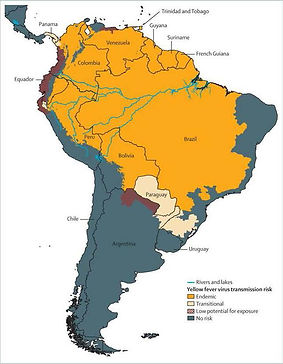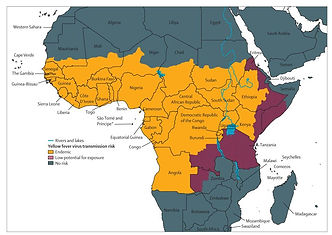
Yellow Fever
Yellow fever virus is found in tropical and subtropical areas in South America and Africa. It is a very rare cause of illness in the United States. Illness ranges in severity from a self-limited febrile illness to severe liver disease with bleeding.
Historical Data
-
Has been found in Virginia
-
September 1, 1855 to 1860, Norfolk and Portsmouth, Virginia, estimated 3200 victims
-
-
Previous outbreaks
-
Started in Africa, spread to Caribbean and Haiti
-
Latin America and Mexico
-
United States: Pennsylvania, Louisiana
-
Transmission, Pathogens & Vectors
-
The virus is transmitted to people by the bite of an infected mosquito
-
Yellow fever virus is an RNA virus that belongs to the genus Flavivirus
-
Related to West Nile, St. Louis encephalitis, and Japanese encephalitis viruses
-
Infected by Aedes aegypti or Haemagogus aegypti species mosquitoes
-
Mosquitoes get the virus by feeding on infected primates and then can transit the virus to other primates
-
People infected with yellow fever virus are infectious to mosquitoes shortly before the onset of fever and up to 5 days after onset
Symptoms
-
Most people are asymptomatic or only have mild symptoms
-
Flu like symptoms after an incubation period of 3 to 6 days
-
Chills
-
Severe headache
-
Body aches and pains in back
-
Fatigue and weakness
-
Nausea and vomiting
-
After initial phase of symptoms, most people improve but some may develop more aggressive symptoms including high fever, jaundice, bleeding, and even organ failure
Treatment
-
No specific treatments have been found for people infected
-
There are vaccines in the U.S. for people traveling to prevent Yellow Fever
-
Resting, with plenty of water and taking pain relievers should help with most symptoms




